Questions
- The diagram below shows a transparent water tank containing water. An electric light is fixed at corner A of the tank. A light ray from the slit shines on the water surface BC at an angle of 480 as shown
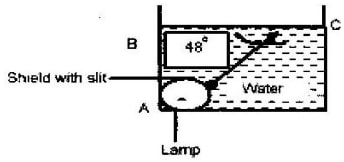
-
- Determine the angle of refraction for the ray shown in the diagram.
- Complete the diagram to show the refracted ray.
- Determine the angle of incidence for which the angle of refraction is 900
- Calculate the speed of light in water (nw = 4/3, C= 3 x 108 m/s)
-
- The figure shows the path of a yellow light through a glass prism. The speed of yellow light in the prism is 1.88 x 108 m/s.

- Determine the refractive index of the prism material for the light. (Speed of light in vacuum = 3.0 x 108 ms-1)
- Show on the figure the critical angle C and determine the value.
- Given that r= 21.20, determine angle Q.
- On the same figure, sketch the path of the light after striking the prism if the prism was replaced by another of similar shape but lower refractive index. (Use dotted line for your answer).
- The figure below shows two rays A and B entering a semi circular glass block which has critical angle of 420. The rays are incident at an air glass boundary at point O
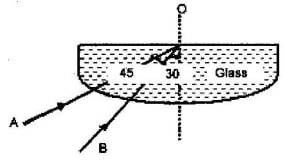
Complete the path of the two rays from point O. Label A1 and B1 the corresponding rays. - A ray of light is directed at an angle of 500 on to a liquid-air boundary.
The refractive index of the liquid is 1.4.
Show on a diagram the patch taken by the ray on striking the liquid-air boundary. Show how you arrive at your answer. - The figure below shows a coin placed in a large empty container. An observer looking into the container from the position shown is unable to see the coin.
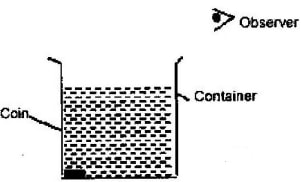
Sketch two rays from a point on the coin to show how the observer is able to see the image of the coin after the container is filled with water. - The figure below show a ray of light incident on the face of a water prism.
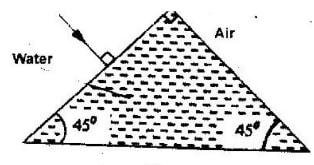
Sketch the path of the rays as it passes through the prism. Critical angle for water is 490 (1mk) - Calculate the refractive index of glass given that the velocity of light in air is 3x 108 ms-1 and velocity of light in glass is 2.4 x 108 ms-1.
- The real thickness of crown glass block of refractive index 1.58 is 10 cm. Calculate the apparent thickness of the glass.
- You are provided with the following;
- A 50 cm beaker full of water.
- Stand and clangs
- A half metre rule
- 2 optical pins
- Cork- Explain briefly how you would determine the refraction index of water using the materials provided.
- The data below shows the results obtained when such an experiment was performed by form three students using various values of real depths, Y of a liquid.
Real depth cm
30
50
70
90
110
130
Apparent depth cm
22
37
52
66
81
96
- Plot a graph of the real depth (y-axis) against apparent depth.
- From the graph, determine the refractive index of the liquid.
- Paraffin has a greater refractive index than that of water. Comment about the relative velocity of light in paraffin and in water.
-
- State snell's law
- A ray of light travels from air into medium 1 and 2 as shown.
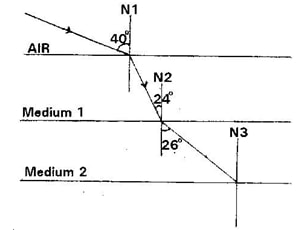
Calculate;- The refractive index of medium 1.
- Critical angle of medium 1
- The refractive index of medium 2 relative to medium (1n2)
- Explain with the aid of a diagram, how a suitable glass prism may be used to turn a ray of light 1800
- What measurable quantity is associated with colour of light?
- State TWO uses of total internal reflection.
- The graph shown below shows, the apparent depth (y-axis) against real depth. Use it to calculate the refractive index of glass.
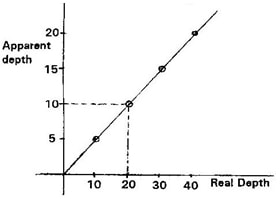
- The refractive index for air-water boundary is 4/3. Calculate the critical cycle for water–air interface.
Answers
-
-
- Sin 48 = 3
Sin r 4
Sin r = 0.9906
= 82.20
- Sin 48 = 3
- Sin C = 1/n = 0.75
C= 48.60
i.e. when r= 90, I= C
Va = n
Vw
3 x 108 = 4
Vw 3
∴ Vw = 2.25 x 108 m/s
-
-
- n= Va = 3.00 x 108 = 1.6
Vp 1.88 x 108 -
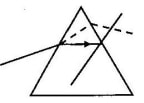
Sin C = 1/1.6
C = 38.8 - Sin Q = 1.6
Sin 21.2
Q= 35.40
- n= Va = 3.00 x 108 = 1.6
-
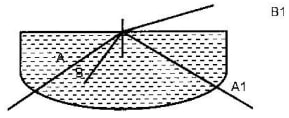
- Sin C= 1/n = 1/1.4
C= 45.6
∴ Total internal reflection will take place. -
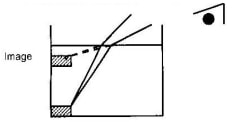
-
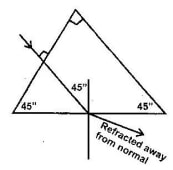
- ang = Velocity of light in air
= Velocity of light in glass
= 3x 108
= 2.4 x 108
= 1.25 - ηg = Real thickness
Apparent thickness
1.58= 10/Apparent thickness
Apparent thickness = 10/1.58 = 6.33cm
The apparent thickness of crown glass block = 6.33cm -
-

- Set the apparatus as shown above.
- Adjust the search pin to no-parallax position.
- Using the metre rule, measure the apparatus distance x and the real depth y of the water.
- Repeat the experiment for other values of y
- Plot a graph of y against x.
Refractive index = gradient of graph
= Real depth
Apparent depth
ηw = y/x -
- Graph
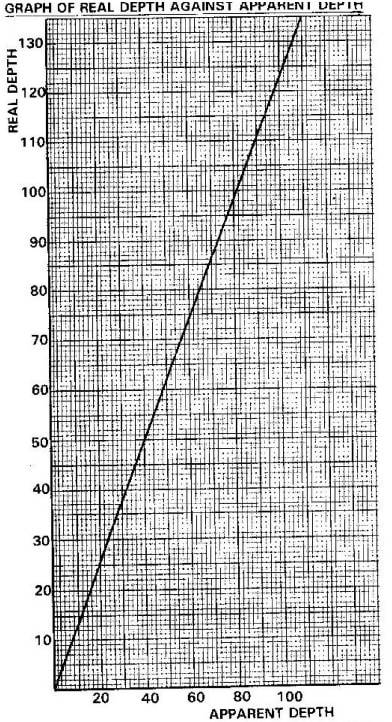
- η1 = Real depth = gradient of the graph
Apparent depth
Gradient = 135 = 1.35
100
∴ Refractive index, η1=1.35
- Graph
-
- Bending of light is more in paraffin than in water.
Thus speed of light in paraffin is less than that in water. -
- Ratio of sine of angle of incidence to sine of angle of refraction is always a constant i.e.
η = Sin I in medium 1
Sin r in medium 2 -
- aη1 = Sin i
sin r
= sin 400 = 0.6428
Sin 240 = 0.4067
= 1.581 - aη1 = 1/Sin C Where C is the critical angle then
1.581= 1/Sin C
Sin C =1/1.581 = 0.6325
C = sin-1 0.6325
= 39.230
Critical angle = 39.230 - 1η2 = sin I in 1
Sin r in 2
= Sin 240 = 0.4067
Sin 260 0.4384
= 0.9277
- aη1 = Sin i
- Ratio of sine of angle of incidence to sine of angle of refraction is always a constant i.e.
- Solution;
Use a right angled prism.
Ray meets longest side of prism at 900 and passes undeviated. It makes an angle of 450 with normal at O1 and is totally internally reflected. The reflected ray makes an angle of 450 with normal at O2 and is totally reflected as shown. Total deviation = (4 x 45)0 = 1800 - Frequency or wavelength
- Used in;
- Prism periscope
- Optical fibre
- Prism binocular
- Solution;
Gradient of the graph = Apparent depth
Real depth
= 10/20 = ½
But refractive index = Real depth
Apparent depth
ηg = 1/gradient
∴ Refractive index of glass = 2 - Solution;
For light passing from water to air then
wηg = 3/4
Join our whatsapp group for latest updates
Tap Here to Download for 50/-
Get on WhatsApp for 50/-
Download Refraction of Light Questions and Answers - Physics Form 3 Topical Revision.
Tap Here to Download for 50/-
Get on WhatsApp for 50/-
Why download?
- ✔ To read offline at any time.
- ✔ To Print at your convenience
- ✔ Share Easily with Friends / Students

